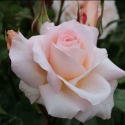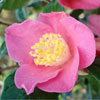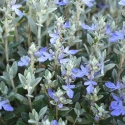Friday 7th June, 2019
OMG What will I say?
Hi
Lloyd is up to his elbows in it!
Lloyd is very busy with the potting team and getting on with the root pruning this week, probably because I couldn't get the deliveries booked further apart and now there are thousands of roses that need to be potted. It's Cathie here and I have been given the opportunity to write the newsletter this week. Do you suppose it is my punishment for landing them with so many roses to bag all at once? Well we are well on our way with potting the new season roses, having received about half of what has been grown for us already, and I have to say it really does look amazing seeing all the newly bagged roses laid out in their neat, straight lines, in alphabetical order. The potting team is doing an
Absolutely Fabulous job and should have them all bagged, ready to send out, hopefully, by the end of next week. We have started sending out our usual email letting you know if your roses are ready but don't be dismayed if you haven't received yours yet as there are many to send and some will be held until all the roses on your order are available. The logistics of it at this time are quite mind boggling but we do have a pretty good system in place.
Many of you have been buying and growing our roses for quite some time and are probably past wanting to read about how to deal with them in this newsletter, but for the team here it is very much our focus, and I am mindful of those of you who are new to the 'addiction' that is roses so I shall continue to spread the word on what to expect when planting your new season roses as it can be a tad off-putting when all the soil falls out of the bag when you cut it open, or worse still, if your rose dies due to being pulled from the bag rather than cut out.
I regularly get asked 'When should I plant my roses' and I usually say anytime so long as you can meet their food and water requirements. New season roses however are always first available in winter as this is their dormant time when they can safely be transplanted from the growers land to the pb's (plastic bags) that we put them in. The potting process is pretty simple, the roots get pruned enough to fit them into the pb and then fill the bag with potting mix while firming the plant in the bag. Over the next few weeks the rose develops small white feeder roots that are fragile so it is important to take care of these roots. It starts with us, the staff, only picking up the rose by the bag, and this goes for you too, always pick the rose up by the bag, not the plant, especially the standards as it is just too easy to grab them by the trunk and carry them by it which can damage all those lovely new feeder roots. This is something for people to remember when visiting the nursery as well, if you are handling the roses here, please do so by the bag.
When deciding where to plant remember that roses like a sunny position with well-drained soil... they don't like wet feet! They also don't like to compete with other plants for soil nutrients or root room so don't overcrowd them with under planting and good air flow is important to reduce mildew problems.
Dig a good size hole, usually twice the width of the bag it's in, and just a little deeper. Break up the dirt clumps so that it is nice and crumbly, this makes the fines pack round the roots so the plant is nice and firm in the ground when you plant it. Unless there is good reason for doing so it is best not to add compost or fertiliser to the soil that you are planting into, mainly because compost can retain too much water and cause root rot issues and fertiliser can burn the roots (always use slow release fert for newly planted plants) and
Remember that there is slow release fertiliser already included in the potting mix. Carefully remove your rose from the bag by cutting down the sides of the bag, preferably over the hole as most of the potting mix will likely fall away. Keep this mix in the hole with the rose as it has been formulated to help your rose develop it's new roots. Position the plant in the hole so the graft sits above the soil level when planted and no deeper than it was when in the bag.
Fill the hole with soil, ensuring it packs in and around the rose roots, tamping down as you fill.
If mulching with compost on the soil surface, take care that it does not touch the plant and of course remember to give your rose a good watering so that all the soil fines settle closely and compactly around the roots. Don't go too hard on the watering after this though as they don't like wet feet. If there is rain about you possibly won't have to water them again unless we get a drying period first.
If you are planting standard, weeping or pillar roses, put your stake firmly in the ground, at the outside of the hole, before you place the plant, this will ensure a good anchorage and no root damage by the stake.
This information is available 24/7 on our website along with lots of other good information. Go to
How To on our website and click Grow Roses, or just click the link in the word that is bold to go straight there now.
I have the pleasure of the best view while sitting at my desk, part of that view being newly arrived plants. Yesterdays delivery of some larger grade
Photinia Red Robins and
Griselinia Broadway Mint took my eye as they are really robust bushy plants. These are in ground grown, evergreens with roots too big to bag easily so they are
wrapped instead in hessian. These are easy to plant as you only need to cut away the string that holds the hessian once you put the plant in the hole, then back fill with dirt, leaving the hessian in place. The roots will grow through the hessian which rots away after a shot time in soil.
I also spied a lovely sculptural plant that Cecilia has
displayed at the side entrance to the shop. It is
Cordyline Red Sensation and it just looked wonderful grouped with an espalliered
Camellia Koto no Kaori behind it and the lovely glossy rich green foliage of the mixed
orientalis hellebores grouped with it. I posted it to facebook but it isn't as good as Lloyds pics so not sure I have fully captured just how good it looks. He would say too much light LOL.
Another
grouping I quite liked was the
Teucrium Silver Box backing
Casuarina Cousin It. This is a new variety of Teucrium that is more upright than Teucrium fruiticans. It is a great low hedge option up to a meter and will cloth itself in purple blue flowers from spring through summer. Hardy and clipable.
Casuarina Cousin It is a good looking, evergreen groundcover that will cope with a range of soil moisture levels from wet to dry. It has a spread of about 1.5m so would quite happily cascade over rocks, banks, flat ground or Cousin It himself. Excellent weed suppressant and low maintenance.
Time to get out the secateurs
Hopefully your roses have been pruned and sprayed by now but if you are in the warmer areas there is still time. Sharpen up those secateurs, assuming you don't have the excellent
ARS brand that holds its edge so well, give your
spray unit some TLC, clean the nozzle and give it a good rinse out in readiness for spraying and pruning your roses and fruit trees for their winter rest. A good spray with
Lime Sulphur or
Liquid Copper and
Conqueror Oil will help defoliate your roses and fruit trees and also mitigate those nasty bug eggs and spores for winter. Use well sharpened secateurs for a nice clean cut and do it all on a nice fine day.
I'll try not to load Lloyd down with too much to pot next week so you can have him back writing your favourite blog.
Have a fabulous weekend
Cheers
Lloyd, Tony and the Wairere Team














